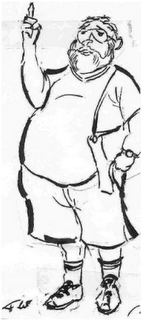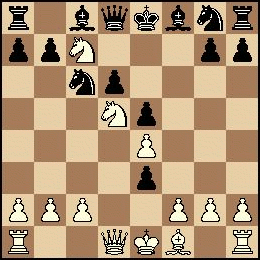A brief history of modern chess
 |
| author - a former chess champion of Brussels. |
The current rules of chess have been used since about 1580, starting in Italy. At the end of the 16th century and during the 17th century, the best players of the word were Spanish and Italian. In the 18th century, the supremacy went to France (Philidor and La Bourdonnais). In the 19th century, England became the most important country for chess. The London chess club was founded in 1807.
The title of Chess Champion of the World dates officially to 1886 (Steinitz), but even before that some players were known to be the best of their time. A dated list of the best players of the word is the following:
| Andre Philidor | (France) | 1747 – 1795 |
| Louis La Bourdonnais | (France) | 1821 – 1840 |
| Howard Staunton | (England) | 1843 – 1851 |
| Adolf Anderssen | (Germany) | 1851 – 1858 |
| Paul Morphy | (U.S.A.) | 1858 – 1859 |
| William Steinitz | (Austria) | 1866 – 1894 |
| Emanuel Lasker | (Germany) | 1894 – 1921 |
| Jose Raoul Capablanca | (Cuba) | 1921 – 1927 |
| Alexander Alekhine | (Russia/France) | 1927 – 1935 |
| Max Euwe | (Holland) | 1935 – 1937 |
| Alexander Alekhine | (Russia/France) | 1937 – 1946 |
| Mikhail Botvinnik | (U.S.S.R.) | 1948 – 1957 |
| Vassily Smislov | (U.S.S.R.) | 1957 - 1958 |
| Mikhail Botvinnik | (U.S.S.R.) | 1958 – 1960 |
| Mikkail Tal | (U.S.S.R.) | 1960 – 1961 |
| Mikhail Botvinnik | (U.S.S.R.) | 1961 – 1963 |
| Tigran Petrossian | (U.S.S.R.) | 1963 – 1969 |
| Boris Spassky | (U.S.S.R.) | 1969 – 1972 |
| Bobby Fischer | (U.S.A.) | 1972 – 1975 |
| Anatoly Karpov | (U.S.S.R.) | 1975 – 1985 |
| Garry Kasparov | (U.S.S.R.) | 1985 – ? |
We see a supremacy of the (ex) Soviet Union, starting in 1948. (Alekhine who became a French citizen and died in 1946.)
Two Americans have been World champion. Another American, Hans Berliner, was also world champion by correspondence in 1968. Dr. Berliner's work with computer chess at Carnegie University attracted world attention. His Hi-tech program was one of the first to defeat chess masters.
Most people consider Robert James (Bobby) Fischer to have been the best chess player of all time, but some consider Paul Morphy to have been as good as Fischer. Let's have a look at a game that Paul Morphy won in only seventeen moves against Adolf Anderssen who was the best in the world for the eight years before him. This game, played only a few days before Christmas, is a wonderful example of Morphy's skill in creating a situation where his tactical skills could wreak havoc and devastation.
Morphy – Anderssen, 1858

|
| diagram #1 |
1. e4 c5 2. Nf3 Nc6 3. d4 cxd4 4. Nxd4 e6 5. Nb5 (diagram #1)
Taimanov variation of the Sicilian. It's inter-esting to see such a modern opening being played well over a century ago.
5... d6 6. Bf4 e5 7. Be3 f5?
Anderssen seeks to open things up and give himself an opportunity to launch one of his dazzling attacks. This had always worked for him before, but it played into Morphy's hands. Modern opening theory considers this to be a weak move for Black. (More common now is 7... Nf6 8. Bg5 a6.)
8. N1c3!
Morphy continued his development in preparation for punishing Black's premature aggression.
8... f4 9.Nd5!
Better than anyone before him, Morphy understood the value of initiative and how it is often much more important than mere material.
9... fxe3
Anderssen was already in trouble, but this move would only add to it. Kf7 might have been wiser.

|
| diagram #2 |
10.Nbc7+ (diagram #2)
10... Kf7
[10...Kd7 11.Qg4#]
11. Qf3+?
Now that his target had been driven into the open, Morphy pursued relentlessly. In this case though, it was a mistake. Nxa8 would have been a much better move; Morphy's immediate pursuit of the black king would have given Anderssen a small chance to draw.
11... Nf6 12. Bc4 Nd4! 13. Nxf6+ d5!
It's unlikely that Anderssen has calculated all variations after Kg6, but his instincts told him it led to disaster. [13... Kg6 14. Qh5+ Kxf6 15. Ne8+ Qxe8 16. Qxe8 Nxc2+ (16... d5 17. 0–0–0 !) 17. Kf1 e2+ ! (17... Nxa1 18. g4 !) 18. Bxe2 Nxa1 19. g4 ! and despite a good material balance Black is defenseless against the new wave of attack. -- Kasparov]
14. Bxd5+ Kg6?
[14...Qxd5 was the safest option, although White has an advantage in the endgame: 15.Nfxd5+ Nxf3+ 16.gxf3 exf2+ 17.Kxf2; 14...Ke7 ! could have made Morphy regret his over-ambitious 11th move, e.g. 15.Qh5 gxf6 16.Qf7+ Kd6 17.Nxa8 -- Kasparov]

|
| digram #3 |
15. Qh5+ (diagram #3)
15... Kxf6 16.fxe3!
A classic Morphy move! The open f-file ends and with it any hope Black has had. His King is exposed and the White rook has an open file to join the attack. [The tempting 16. Ne8+ ? 16... Qxe8 17. Qxe8 Bb4+ would have been disastrous for White.]
16...Nxc2+

|
| Paul Morphy - 1859 |
Anderssen could have held out a little longer with Qxc7, but the end result would still have been the same. [16... Qxc7 17. Rf1+ Nf5 18. Rxf5+ ! 18... Bxf5 19. Qxf5+ Ke7 20. Qe6+ Kd8 21. 0–0–0 ! 21... Bd6 22. Bxb7 -- Kasparov]
17. Ke2
Black resigned. Anderssen realized that his exposed king with White's pieces all about, is doomed, especially with the open f-file. It was a very impressive demolition of the strongest European player of the time.












No comments:
Post a Comment